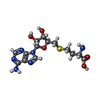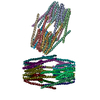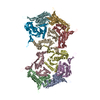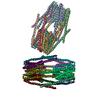+ Open data
Open data
- Basic information
Basic information
| Entry | Database: PDB / ID: 6wkr | ||||||||||||||||||||||||||||||||||||||||||||||||||||||||||||||||||
|---|---|---|---|---|---|---|---|---|---|---|---|---|---|---|---|---|---|---|---|---|---|---|---|---|---|---|---|---|---|---|---|---|---|---|---|---|---|---|---|---|---|---|---|---|---|---|---|---|---|---|---|---|---|---|---|---|---|---|---|---|---|---|---|---|---|---|---|
| Title | PRC2-AEBP2-JARID2 bound to H2AK119ub1 nucleosome | ||||||||||||||||||||||||||||||||||||||||||||||||||||||||||||||||||
 Components Components |
| ||||||||||||||||||||||||||||||||||||||||||||||||||||||||||||||||||
 Keywords Keywords | GENE REGULATION/DNA / chromatin / nucleosome / transcription / cryo-EM / ubiquitination / gene regulation-DNA complex / heterochromatin / DNA binding | ||||||||||||||||||||||||||||||||||||||||||||||||||||||||||||||||||
| Function / homology |  Function and homology information Function and homology informationprotein localization to pericentric heterochromatin / hepatocyte homeostasis / cellular response to trichostatin A / regulation of gliogenesis / negative regulation of striated muscle cell differentiation / regulation of kidney development / [histone H3]-lysine27 N-trimethyltransferase / response to tetrachloromethane / CAF-1 complex / negative regulation of keratinocyte differentiation ...protein localization to pericentric heterochromatin / hepatocyte homeostasis / cellular response to trichostatin A / regulation of gliogenesis / negative regulation of striated muscle cell differentiation / regulation of kidney development / [histone H3]-lysine27 N-trimethyltransferase / response to tetrachloromethane / CAF-1 complex / negative regulation of keratinocyte differentiation / histone H3K27 trimethyltransferase activity / negative regulation of retinoic acid receptor signaling pathway / cerebellar cortex development / primary miRNA binding / random inactivation of X chromosome / regulation of adaxial/abaxial pattern formation / skeletal muscle satellite cell maintenance involved in skeletal muscle regeneration / negative regulation of cardiac muscle cell proliferation / histone H3K27 methyltransferase activity / regulatory ncRNA-mediated heterochromatin formation / sex chromatin / ubiquitin-modified histone reader activity / positive regulation of cell cycle G1/S phase transition / facultative heterochromatin formation / NuRD complex / NURF complex / regulation of cell fate specification / negative regulation of stem cell population maintenance / genomic imprinting / DNA replication-dependent chromatin assembly / Transcription of E2F targets under negative control by p107 (RBL1) and p130 (RBL2) in complex with HDAC1 / ESC/E(Z) complex / negative regulation of stem cell differentiation / regulation of stem cell differentiation / RSC-type complex / protein-lysine N-methyltransferase activity / Polo-like kinase mediated events / cardiac muscle hypertrophy in response to stress / histone H3K9me2/3 reader activity / Transcription of E2F targets under negative control by DREAM complex / chromatin silencing complex / pronucleus / positive regulation of dendrite development / G1 to G0 transition / histone H3 methyltransferase activity / histone methyltransferase activity / DNA methylation-dependent constitutive heterochromatin formation / negative regulation of G1/S transition of mitotic cell cycle / ATPase complex / spinal cord development / lncRNA binding / negative regulation of gene expression, epigenetic / synaptic transmission, GABAergic / G1/S-Specific Transcription / Sin3-type complex / : / Transcriptional Regulation by E2F6 / histone deacetylase complex / positive regulation of stem cell population maintenance / positive regulation of MAP kinase activity / histone methyltransferase complex / oligodendrocyte differentiation / RNA Polymerase I Transcription Initiation / negative regulation of transcription elongation by RNA polymerase II / G0 and Early G1 / positive regulation of protein serine/threonine kinase activity / positive regulation of GTPase activity / negative regulation of cell differentiation / cardiac muscle cell proliferation / positive regulation of epithelial to mesenchymal transition / ribonucleoprotein complex binding / subtelomeric heterochromatin formation / RNA polymerase II core promoter sequence-specific DNA binding / pericentric heterochromatin / Cyclin E associated events during G1/S transition / Transcriptional regulation of brown and beige adipocyte differentiation by EBF2 / Cyclin A:Cdk2-associated events at S phase entry / nucleosome binding / keratinocyte differentiation / spleen development / Regulation of TP53 Activity through Acetylation / protein localization to chromatin / Maturation of protein E / Maturation of protein E / ER Quality Control Compartment (ERQC) / Myoclonic epilepsy of Lafora / FLT3 signaling by CBL mutants / IRAK2 mediated activation of TAK1 complex / Prevention of phagosomal-lysosomal fusion / negative regulation of cytokine production involved in inflammatory response / Alpha-protein kinase 1 signaling pathway / Glycogen synthesis / IRAK1 recruits IKK complex / IRAK1 recruits IKK complex upon TLR7/8 or 9 stimulation / liver regeneration / Endosomal Sorting Complex Required For Transport (ESCRT) / Deposition of new CENPA-containing nucleosomes at the centromere / Membrane binding and targetting of GAG proteins / Negative regulation of FLT3 / Regulation of TBK1, IKKε (IKBKE)-mediated activation of IRF3, IRF7 Similarity search - Function | ||||||||||||||||||||||||||||||||||||||||||||||||||||||||||||||||||
| Biological species |  Homo sapiens (human) Homo sapiens (human) | ||||||||||||||||||||||||||||||||||||||||||||||||||||||||||||||||||
| Method | ELECTRON MICROSCOPY / single particle reconstruction / cryo EM / Resolution: 3.5 Å | ||||||||||||||||||||||||||||||||||||||||||||||||||||||||||||||||||
 Authors Authors | Kasinath, V. / Nogales, E. / Beck, C. / Sauer, P. / Poepsel, S. / Kosmatka, J. / Faini, M. / Toso, D. / Aebersold, R. | ||||||||||||||||||||||||||||||||||||||||||||||||||||||||||||||||||
| Funding support |  United States, 1items United States, 1items
| ||||||||||||||||||||||||||||||||||||||||||||||||||||||||||||||||||
 Citation Citation |  Journal: Science / Year: 2021 Journal: Science / Year: 2021Title: JARID2 and AEBP2 regulate PRC2 in the presence of H2AK119ub1 and other histone modifications. Authors: Vignesh Kasinath / Curtis Beck / Paul Sauer / Simon Poepsel / Jennifer Kosmatka / Marco Faini / Daniel Toso / Ruedi Aebersold / Eva Nogales /    Abstract: Polycomb repressive complexes 1 and 2 (PRC1 and PRC2) cooperate to determine cell identity by epigenetic gene expression regulation. However, the mechanism of PRC2 recruitment by means of recognition ...Polycomb repressive complexes 1 and 2 (PRC1 and PRC2) cooperate to determine cell identity by epigenetic gene expression regulation. However, the mechanism of PRC2 recruitment by means of recognition of PRC1-mediated H2AK119ub1 remains poorly understood. Our PRC2 cryo-electron microscopy structure with cofactors JARID2 and AEBP2 bound to a H2AK119ub1-containing nucleosome reveals a bridge helix in EZH2 that connects the SET domain, H3 tail, and nucleosomal DNA. JARID2 and AEBP2 each interact with one ubiquitin and the H2A-H2B surface. JARID2 stimulates PRC2 through interactions with both the polycomb protein EED and the H2AK119-ubiquitin, whereas AEBP2 has an additional scaffolding role. The presence of these cofactors partially overcomes the inhibitory effect that H3K4me3 and H3K36me3 exert on core PRC2 (in the absence of cofactors). Our results support a key role for JARID2 and AEBP2 in the cross-talk between histone modifications and PRC2 activity. | ||||||||||||||||||||||||||||||||||||||||||||||||||||||||||||||||||
| History |
|
- Structure visualization
Structure visualization
| Movie |
 Movie viewer Movie viewer |
|---|---|
| Structure viewer | Molecule:  Molmil Molmil Jmol/JSmol Jmol/JSmol |
- Downloads & links
Downloads & links
- Download
Download
| PDBx/mmCIF format |  6wkr.cif.gz 6wkr.cif.gz | 727.6 KB | Display |  PDBx/mmCIF format PDBx/mmCIF format |
|---|---|---|---|---|
| PDB format |  pdb6wkr.ent.gz pdb6wkr.ent.gz | 549.5 KB | Display |  PDB format PDB format |
| PDBx/mmJSON format |  6wkr.json.gz 6wkr.json.gz | Tree view |  PDBx/mmJSON format PDBx/mmJSON format | |
| Others |  Other downloads Other downloads |
-Validation report
| Summary document |  6wkr_validation.pdf.gz 6wkr_validation.pdf.gz | 1.4 MB | Display |  wwPDB validaton report wwPDB validaton report |
|---|---|---|---|---|
| Full document |  6wkr_full_validation.pdf.gz 6wkr_full_validation.pdf.gz | 1.5 MB | Display | |
| Data in XML |  6wkr_validation.xml.gz 6wkr_validation.xml.gz | 109.6 KB | Display | |
| Data in CIF |  6wkr_validation.cif.gz 6wkr_validation.cif.gz | 174.5 KB | Display | |
| Arichive directory |  https://data.pdbj.org/pub/pdb/validation_reports/wk/6wkr https://data.pdbj.org/pub/pdb/validation_reports/wk/6wkr ftp://data.pdbj.org/pub/pdb/validation_reports/wk/6wkr ftp://data.pdbj.org/pub/pdb/validation_reports/wk/6wkr | HTTPS FTP |
-Related structure data
| Related structure data |  21707MC M: map data used to model this data C: citing same article ( |
|---|---|
| Similar structure data |
- Links
Links
- Assembly
Assembly
| Deposited unit | 
|
|---|---|
| 1 |
|
- Components
Components
-Protein , 9 types, 15 molecules TFNCBEPIOJQKRMS
| #1: Protein | Mass: 8622.922 Da / Num. of mol.: 2 Source method: isolated from a genetically manipulated source Source: (gene. exp.)  Homo sapiens (human) / Gene: UBC / Production host: Homo sapiens (human) / Gene: UBC / Production host:  #4: Protein | | Mass: 47709.527 Da / Num. of mol.: 1 Source method: isolated from a genetically manipulated source Source: (gene. exp.)  Homo sapiens (human) / Gene: RBBP4, RBAP48 / Production host: Homo sapiens (human) / Gene: RBBP4, RBAP48 / Production host:  Trichoplusia ni (cabbage looper) / References: UniProt: Q09028 Trichoplusia ni (cabbage looper) / References: UniProt: Q09028#5: Protein | | Mass: 85492.297 Da / Num. of mol.: 1 Source method: isolated from a genetically manipulated source Source: (gene. exp.)  Homo sapiens (human) / Gene: EZH2, KMT6 / Production host: Homo sapiens (human) / Gene: EZH2, KMT6 / Production host:  Trichoplusia ni (cabbage looper) Trichoplusia ni (cabbage looper)References: UniProt: Q15910, [histone H3]-lysine27 N-trimethyltransferase #6: Protein | Mass: 49306.074 Da / Num. of mol.: 2 Source method: isolated from a genetically manipulated source Source: (gene. exp.)  Homo sapiens (human) / Gene: JARID2, JMJ / Production host: Homo sapiens (human) / Gene: JARID2, JMJ / Production host:  Trichoplusia ni (cabbage looper) / References: UniProt: Q92833 Trichoplusia ni (cabbage looper) / References: UniProt: Q92833#7: Protein | | Mass: 33012.668 Da / Num. of mol.: 1 Source method: isolated from a genetically manipulated source Source: (gene. exp.)  Homo sapiens (human) / Gene: AEBP2 / Production host: Homo sapiens (human) / Gene: AEBP2 / Production host:  Trichoplusia ni (cabbage looper) / References: UniProt: Q6ZN18 Trichoplusia ni (cabbage looper) / References: UniProt: Q6ZN18#9: Protein | Mass: 15421.101 Da / Num. of mol.: 2 Source method: isolated from a genetically manipulated source Source: (gene. exp.)  #10: Protein | Mass: 11394.426 Da / Num. of mol.: 2 Source method: isolated from a genetically manipulated source Source: (gene. exp.)  #11: Protein | Mass: 14067.398 Da / Num. of mol.: 2 Source method: isolated from a genetically manipulated source Source: (gene. exp.)  #12: Protein | Mass: 13979.291 Da / Num. of mol.: 2 Source method: isolated from a genetically manipulated source Source: (gene. exp.)  |
|---|
-Polycomb protein ... , 2 types, 2 molecules AL
| #2: Protein | Mass: 83181.922 Da / Num. of mol.: 1 Source method: isolated from a genetically manipulated source Source: (gene. exp.)  Homo sapiens (human) / Gene: SUZ12, CHET9, JJAZ1, KIAA0160 / Production host: Homo sapiens (human) / Gene: SUZ12, CHET9, JJAZ1, KIAA0160 / Production host:  Trichoplusia ni (cabbage looper) / References: UniProt: Q15022 Trichoplusia ni (cabbage looper) / References: UniProt: Q15022 |
|---|---|
| #3: Protein | Mass: 50267.691 Da / Num. of mol.: 1 Source method: isolated from a genetically manipulated source Source: (gene. exp.)  Homo sapiens (human) / Gene: EED / Production host: Homo sapiens (human) / Gene: EED / Production host:  Trichoplusia ni (cabbage looper) / References: UniProt: O75530 Trichoplusia ni (cabbage looper) / References: UniProt: O75530 |
-DNA chain , 1 types, 1 molecules H
| #8: DNA chain | Mass: 98186.094 Da / Num. of mol.: 1 / Source method: obtained synthetically / Source: (synth.)  Homo sapiens (human) Homo sapiens (human) |
|---|
-Non-polymers , 3 types, 3 molecules 




| #13: Chemical | ChemComp-MG / |
|---|---|
| #14: Chemical | ChemComp-SAH / |
| #15: Chemical | ChemComp-ZN / |
-Details
| Has ligand of interest | Y |
|---|---|
| Has protein modification | Y |
-Experimental details
-Experiment
| Experiment | Method: ELECTRON MICROSCOPY |
|---|---|
| EM experiment | Aggregation state: PARTICLE / 3D reconstruction method: single particle reconstruction |
- Sample preparation
Sample preparation
| Component |
| ||||||||||||||||||||||||
|---|---|---|---|---|---|---|---|---|---|---|---|---|---|---|---|---|---|---|---|---|---|---|---|---|---|
| Molecular weight | Value: 0.5 MDa / Experimental value: NO | ||||||||||||||||||||||||
| Source (natural) |
| ||||||||||||||||||||||||
| Source (recombinant) |
| ||||||||||||||||||||||||
| Buffer solution | pH: 7.9 | ||||||||||||||||||||||||
| Specimen | Embedding applied: NO / Shadowing applied: NO / Staining applied: NO / Vitrification applied: YES | ||||||||||||||||||||||||
| Specimen support | Grid material: GOLD / Grid mesh size: 300 divisions/in. / Grid type: Quantifoil R2/2 | ||||||||||||||||||||||||
| Vitrification | Instrument: FEI VITROBOT MARK IV / Cryogen name: ETHANE / Humidity: 100 % / Chamber temperature: 278 K |
- Electron microscopy imaging
Electron microscopy imaging
| Experimental equipment |  Model: Titan Krios / Image courtesy: FEI Company |
|---|---|
| Microscopy | Model: FEI TITAN KRIOS |
| Electron gun | Electron source:  FIELD EMISSION GUN / Accelerating voltage: 300 kV / Illumination mode: FLOOD BEAM FIELD EMISSION GUN / Accelerating voltage: 300 kV / Illumination mode: FLOOD BEAM |
| Electron lens | Mode: BRIGHT FIELD |
| Image recording | Electron dose: 50 e/Å2 / Film or detector model: GATAN K3 BIOQUANTUM (6k x 4k) |
- Processing
Processing
| Software | Name: PHENIX / Version: 1.17.1_3660: / Classification: refinement | ||||||||||||||||||||||||
|---|---|---|---|---|---|---|---|---|---|---|---|---|---|---|---|---|---|---|---|---|---|---|---|---|---|
| EM software |
| ||||||||||||||||||||||||
| CTF correction | Type: PHASE FLIPPING AND AMPLITUDE CORRECTION | ||||||||||||||||||||||||
| Symmetry | Point symmetry: C1 (asymmetric) | ||||||||||||||||||||||||
| 3D reconstruction | Resolution: 3.5 Å / Resolution method: FSC 0.143 CUT-OFF / Num. of particles: 168601 / Symmetry type: POINT | ||||||||||||||||||||||||
| Refine LS restraints |
|
 Movie
Movie Controller
Controller










 PDBj
PDBj




























































